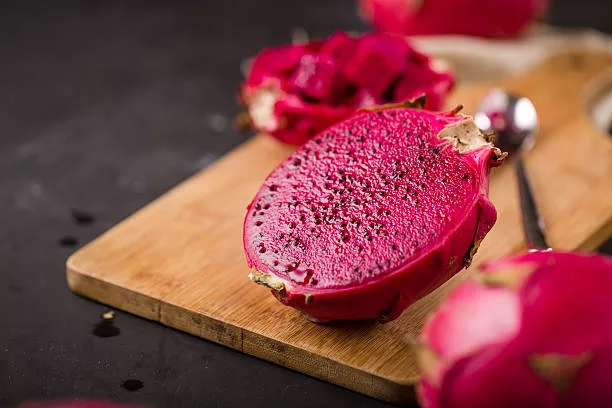Dragon fruit, also called pitaya, is a cactus-derived fruit with numerous health perks, like preventing blood sugar spikes and aiding digestion. Its name comes from its dragon-like appearance. Wondering how to eat it? It’s easy. Slice it in half and scoop out the inside with a spoon. You can also whip up a delicious smoothie using this vibrant fruit.
What is Dragon Fruit?
Dragon fruit, also known as pitaya or pitahaya, is a tropical fruit that belongs to the cactus family. It is native to Central America but is now cultivated in many parts of the world. The fruit has a distinctive appearance, featuring bright pink or yellow skin with green scales and white or red flesh speckled with tiny black seeds. Dragon fruit has a mildly sweet and mildly tangy taste, and its texture is often compared to that of kiwi. Besides being visually appealing, dragon fruit is praised for its nutritional content, providing essential vitamins, minerals, and antioxidants.

Types of Dragon Fruit:
There are several types of dragon fruit, each with its unique characteristics. The two main species are:
- Hylocereus Undatus (White-Fleshed Dragon Fruit): This is the most common variety with vibrant pink or yellow skin and white flesh. The flesh is mildly sweet with a subtle taste, and it is speckled with small, black seeds.
- Hylocereus Costaricensis (Red-Fleshed Dragon Fruit): Also known as the red dragon fruit, this variety has bright pink or red skin and vibrant red flesh. It tends to be sweeter than the white-fleshed variety.
Apart from these primary types, there are hybrids and variations developed through cultivation. Some notable varieties include:
- Yellow Dragon Fruit: This type has yellow skin with white or yellow flesh and is often considered slightly sweeter than the white-fleshed variety.
- Purple Dragon Fruit: This variety has vibrant purple skin and purple or pink flesh. It is known for its rich and sweet flavor.
The specific characteristics can vary based on factors such as the fruit’s origin, growing conditions, and cultivation methods. Dragon fruit is versatile, and the various types offer a range of flavors and appearances for consumers to enjoy.
How Does It Taste?
Dragon fruit, also known as Pitaya, has a taste that’s a mix of kiwi and pear. When you cut it open, it might remind you of an Oreo smoothie due to its white pulp and small black seeds. This tropical fruit isn’t just tasty; it’s also super healthy. Here’s why you should include dragon fruit in your daily diet.
How to Cut Dragon Fruit?
Cutting a dragon fruit is a simple process. Here’s a step-by-step guide:
- Choose a Ripe Dragon Fruit: Pick a dragon fruit that has bright, evenly colored skin. It should give slightly when pressed, indicating ripeness.
- Wash the Fruit: Rinse the dragon fruit under cold water to remove any dirt or debris from the skin.
- Cut off the Ends: Use a sharp knife to slice off both ends of the dragon fruit.
- Slice in Half: Stand the fruit upright and cut it in half vertically. You should now have two halves.
- Peel the Skin: Hold each half and gently peel away the skin from the flesh. Dragon fruit skin is not typically eaten.
- Cut into Wedges or Cubes: Once peeled, you can slice the dragon fruit into wedges or cubes, depending on your preference.
- Enjoy: The dragon fruit is now ready to eat! You can enjoy it on its own, add it to fruit salads, or use it as a topping for desserts and yogurt.
Remember, the skin of the dragon fruit is not only inedible but also often serves as a natural indicator of ripeness. The vibrant color and slight give when pressed are good signs that the fruit is ready to be enjoyed.
Nutritional Value of Dragon Fruit:
Dragon fruit is a nutrient-rich tropical fruit with several health benefits. It is low in calories and provides essential vitamins and minerals. A typical serving includes:
- Vitamins: Dragon fruit is a good source of vitamin C, known for its immune-boosting properties. It also contains small amounts of vitamins like B1 (thiamine), B2 (riboflavin), B3 (niacin), and B6.
- Minerals: The fruit contains essential minerals such as iron, magnesium, and phosphorus, contributing to overall well-being.
- Dietary Fiber: Dragon fruit is rich in dietary fiber, supporting digestive health and helping maintain a feeling of fullness.
- Antioxidants: Packed with antioxidants, including betalains and flavonoids, dragon fruit helps combat oxidative stress and reduce inflammation in the body.
- Hydration: With its high water content, dragon fruit contributes to hydration, promoting healthy skin and supporting bodily functions.
- Low Fat: Dragon fruit is naturally low in fat, making it a nutritious and guilt-free snack.
Incorporating dragon fruit into your diet not only adds a burst of flavor but also provides a range of essential nutrients for overall health and well-being.
Antioxidants in Dragon Fruit:
The main benefit of antioxidants is to capture and get rid of free radicals. Free radicals can cause cell damage and destruction which may lead to a host of issues from heart problems to cancer if left untreated.
The primary role of antioxidants is to capture and eliminate free radicals, which can cause cell damage and contribute to various health issues, including heart problems and cancer if left unchecked.
In Dragon Fruit, antioxidants serve specific purposes:
- Betalains: Found in the red pigments of dragon fruit flesh, betalains are associated with protecting against bad cholesterol (LDL). They help prevent LDL oxidation and damage, promoting heart health.
- Hydroxycinnamates: This group of antioxidants in dragon fruit is linked to anti-cancer benefits. Studies, albeit in test tubes and animals, have indicated their potential to prevent or reduce cancer growth.
- Flavonoids: Present in many fruits and vegetables, flavonoids are a diverse group of antioxidants. In dragon fruit, they are associated with improved brain health and function, along with a lower risk of developing cardiovascular diseases.
Incorporating dragon fruit into your diet can be a flavorful way to benefit from these antioxidants and support overall health.
Benefits of Dragon Fruit (Pitaya):
A captivating anecdote about this fruit suggests that the Chinese believe it originated from the fire of a dragon during battle. However, setting aside the myth, let’s explore the actual reasons why dragon fruit is beneficial for our health.
Here’s a compilation of 10 health advantages associated with consuming dragon fruit.
- Reducing the Risk of Diabetes with Dragon Fruit: Dragon fruit, with its rich nutritional profile, may contribute to lowering the risk of diabetes. The fruit has a low glycemic index, meaning it has a minimal impact on blood sugar levels. The dietary fiber in dragon fruit helps regulate blood sugar by slowing down the absorption of sugar in the digestive tract.
- Reducing the Risk of Cancer with Dragon Fruit: Dragon fruit contains antioxidants like hydroxycinnamates, which have shown potential anti-cancer properties in studies. While further research is needed, these antioxidants are believed to help prevent or decrease cancer cell growth.
- Boosting Immunity with Dragon Fruit: Dragon fruit is a potent source of vitamin C, a vital nutrient known for its immune-boosting properties. Adequate vitamin C intake is crucial for maintaining a robust immune system, as it enhances the production of white blood cells and acts as an antioxidant, protecting cells from damage.
- Promoting Digestive Health with Dragon Fruit: Dragon fruit is rich in dietary fiber, a key element for maintaining a healthy digestive system. Fiber aids in proper digestion by promoting regular bowel movements and preventing constipation. Moreover, it supports the growth of beneficial gut bacteria, contributing to a balanced and thriving gut microbiome.
- Supporting Heart Health with Dragon Fruit: Dragon fruit offers benefits for heart health through various mechanisms. The presence of betalains, antioxidants found in the vibrant red flesh of the fruit, is associated with protection against bad cholesterol (LDL). These antioxidants help prevent the oxidation and damage of LDL cholesterol, potentially reducing the risk of cardiovascular issues.
- Combatting Aging Skin with Dragon Fruit: Dragon fruit is packed with antioxidants, including vitamin C and betalains, which play a crucial role in fighting signs of aging on the skin. These antioxidants help neutralize free radicals, which can contribute to premature aging by causing oxidative stress.
- Nourishing Hair Health with Dragon Fruit: Dragon fruit’s nutrient-rich composition extends its benefits to hair health. The fruit contains essential vitamins and minerals, such as vitamin C, B vitamins, and iron, which contribute to maintaining healthy hair.
- Supporting Bone Health with Dragon Fruit: Calcium is a key component of bone structure, while phosphorus plays a role in bone mineralization and the formation of a sturdy skeletal framework. Including dragon fruit in your diet, alongside other calcium-rich foods, can be a delicious and nutritious way to support overall bone health and ensure the integrity of your skeletal system.
- Nourishing Eye Health with Dragon Fruit: Dragon fruit contains essential nutrients beneficial for eye health. The presence of vitamin A, as well as antioxidants like beta-carotene, contributes to maintaining good vision and overall eye function.
- Pregnancy-Friendly Benefits of Dragon Fruit: Dragon fruit offers nutritional advantages that can be beneficial during pregnancy. Rich in essential vitamins and minerals, including vitamin C, B vitamins, iron, and folate, dragon fruit supports the health of both the expectant mother and the developing baby.
Side Effects Of Dragon Fruit:
While dragon fruit is generally safe for consumption and offers numerous health benefits, some individuals may experience certain side effects. It’s important to be aware of potential reactions, although they are typically rare. Here are some possible side effects:
- Allergic Reactions: In rare cases, individuals may be allergic to components in dragon fruit, leading to symptoms such as itching, swelling, or hives. If you experience any allergic reactions, it’s essential to seek medical attention.
- Digestive Issues: Some people may experience mild digestive issues, such as diarrhea or abdominal discomfort, especially if they consume dragon fruit in excessive amounts.
- Laxative Effect: The high fiber content in dragon fruit can have a mild laxative effect, leading to increased bowel movements. It’s advisable to moderate consumption, especially for those with sensitive digestive systems.
- Blood Sugar Levels: While dragon fruit has a low glycemic index, individuals with diabetes should monitor their blood sugar levels, as the fruit does contain natural sugars.
- Oxalate Content: Dragon fruit contains oxalates, which can contribute to the formation of kidney stones in susceptible individuals. Those with a history of kidney stones may need to moderate their intake.
It’s crucial to note that these side effects are generally uncommon, and many people can enjoy dragon fruit without any adverse reactions. If you have existing health conditions or concerns, it’s advisable to consult with a healthcare professional before making significant changes to your diet.
Dragon Fruit Recipes:
Certainly! Here are a few delicious dragon fruit recipes for you to try:
Dragon Fruit Smoothie:
Ingredients:
- 1 cup diced dragon fruit
- 1 banana
- 1/2 cup Greek yogurt
- 1/2 cup coconut water
- Ice cubes
Instructions:
- Blend all the ingredients until smooth. Adjust the consistency by adding more coconut water if needed. Pour into a glass and enjoy!
Dragon Fruit Salad:
Ingredients:
- 1 dragon fruit, diced
- 1 cup pineapple chunks
- 1 cup mango cubes
- Fresh mint leaves
- Lime juice
Instructions:
Gently toss the dragon fruit, pineapple, and mango in a bowl. Squeeze lime juice over the fruit and garnish with fresh mint leaves. Chill before serving.
Dragon Fruit Salsa:
Ingredients:
- 1 dragon fruit, diced
- 1/2 red onion, finely chopped
- 1 jalapeño, minced
- 1/4 cup cilantro, chopped
- Lime juice
- Salt and pepper to taste
Instructions:
- Combine all the ingredients in a bowl. Mix well and let it sit for about 15 minutes to allow the flavors to meld. Serve with tortilla chips or as a topping for grilled chicken or fish.
Dragon Fruit Sorbet:
Ingredients:
- 2 cups dragon fruit, frozen
- 1/4 cup honey or agave syrup
- 1 tablespoon lime juice
Instructions:
In a glass, layer Greek yogurt, diced dragon fruit, and granola. Repeat the layers. Drizzle honey on top and enjoy this colorful and nutritious parfait.
Feel free to customize these recipes based on your preferences and enjoy the vibrant and tropical flavors of dragon fruit!
FAQ:
- What is dragon fruit? Dragon fruit, also known as pitaya, is a tropical fruit that belongs to the cactus family. It has a distinctive appearance with bright-colored skin, usually pink or yellow, and white or red flesh speckled with small black seeds.
- Is dragon fruit good for you? Yes, dragon fruit is highly nutritious and offers various health benefits. It is rich in antioxidants, vitamins, and minerals, making it a healthy addition to your diet.
- How do you choose a ripe dragon fruit? Look for bright, evenly colored skin without too many blemishes. The fruit should give slightly when pressed, indicating ripeness. A sweet aroma is also a good sign.
- How do you eat dragon fruit? Cut the dragon fruit in half, then scoop out the flesh with a spoon. You can also peel the skin and cut the flesh into slices or cubes. The skin is not typically eaten.
- Does dragon fruit have any side effects? While rare, some individuals may experience allergic reactions or mild digestive issues. Excessive consumption may lead to a laxative effect. People with diabetes should monitor their blood sugar levels due to the fruit’s natural sugars.
- Can pregnant women eat dragon fruit? Yes, dragon fruit can be a healthy choice for pregnant women as it provides essential vitamins and minerals. However, it’s advisable to consult with a healthcare professional for personalized dietary recommendations.
- How to store dragon fruit? Store ripe dragon fruit in the refrigerator for up to two days. If not yet ripe, keep it at room temperature until it ripens. Once cut, store the remaining fruit in the fridge.
- Can you freeze dragon fruit? Yes, you can freeze dragon fruit. Cut the flesh into cubes, place them on a tray to freeze individually, and then transfer to a freezer bag for longer storage. Frozen dragon fruit works well in smoothies and desserts.
- What does dragon fruit taste like? Dragon fruit has a mildly sweet and subtly tangy taste. The white-fleshed variety is often compared to a blend of kiwi and pear, while the red-fleshed variety can be slightly sweeter.
- Are there different types of dragon fruit? Yes, there are different types of dragon fruit, including white-fleshed and red-fleshed varieties. Some variations have yellow or purple skin. Each type may have a slightly different taste and appearance.
Remember that individual responses to dragon fruit can vary, and it’s always a good idea to consult with healthcare professionals for specific dietary advice.
Incorporating dragon fruit into your diet with these recipes can be a flavorful and nutritious way to enjoy its numerous health benefits.






![Top 10 Best Career Options In Future In Demand Jobs Of The Future Top 10 Best Career Options In The Future [In-Demand Jobs Of The Future]](https://theawakenbuddha.com/wp-content/uploads/2023/10/Top-10-Best-Career-Options-in-Future-In-demand-Jobs-of-the-Future-260x195.webp)


